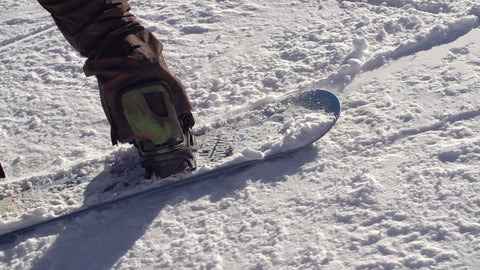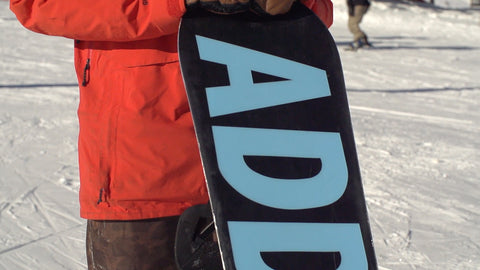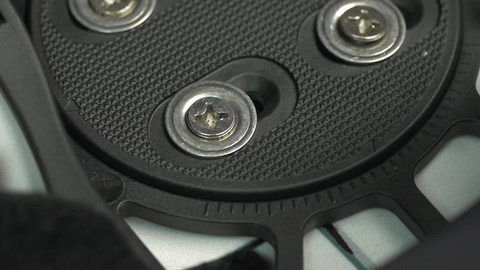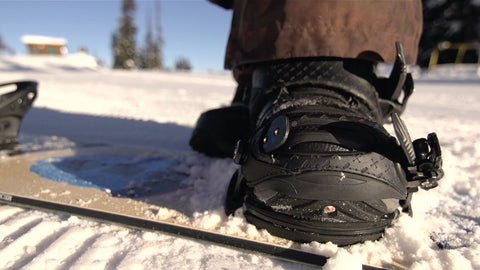
Parts Of A Snowboard
In this blog, we are going to explain the different parts of a snowboard to expand your shred knowledge. This way, even if you don't know what you're talking about, you at least sound like you do.
This month, we added four new tutorials to our Snowboard Tutorial Membership! Remember to check it out for complete access to the world's best snowboard tutorials.
(Narrating/Riding: Duncan Mainland & Nev Lapwood. Filming/Editing: Vince Emond. Filmed At: Whistler Blackcomb)
Basic Orientation
Every snowboard has a nose and tail, sometimes referred to as the tip and tail. The nose, or tip of of your board is the front of your board when you are riding in your normal riding position (regular or goofy).
 That is a Nose.
That is a Nose.
The tail, is behind your back foot.
 And this is a Tail.
And this is a Tail.
The Board
The bottom of your board, that is in frequent contact with the snow is called the base. Contrary to surfing, this is the part of your snowboard that gets waxed to keep you gliding over the snow. It's made of a material called polyethylene that has tiny pours that soak up wax when heated, and close over when cold. This way, your wax is slowly extruded through the base. Wax your board regularly!
 The key to speed, a well waxed base.
The key to speed, a well waxed base.
The top of your snowboard is known as the topsheet, and is where your bindings attach. The topsheet also has all the pretty graphics which make you a better snowboarder. Obviously.
Bindings
Bindings are what keep your foot attached to your snowboard and is all that stands between you stomping the trick and certain death.
 A nicely mounted pair of bindings.
A nicely mounted pair of bindings.
The bottom of the binding is always referred to as the baseplate, with a disk which allows you to change the angle of the bindings.
 This is how you adjust the baseplate and disk to find your perfect angles.
This is how you adjust the baseplate and disk to find your perfect angles.
There are a few different styles of bindings out there, but the most common bindings come with two straps:
- An ankle strap which secures your ankle using a buckle and ladder
- A toe strap or toe cap, which secures your toe using a buckle and ladder also
 Trick Tip: DO NOT place your toe cap over the top of your boot. They are designed to fit around the toe of your boot like this.
Trick Tip: DO NOT place your toe cap over the top of your boot. They are designed to fit around the toe of your boot like this.
Bindings should also have a high back, which rests against your calf. High backs are adjustable and can make your board more responsive or more forgiving. All companies have their own adjustment system, but it will be located at the back of the high back.
Edges
Around the base of your board there is a metal edge which allows your edges to dig into the snow to make turns. As you guessed, the edge under your toes, is a toe edge. That edge under your heels, is called a heel edge. WOW!
 Quiz time! What type of edge is this?
Quiz time! What type of edge is this?
Shape
Snowboards come in a variety of shapes. If you look down the edge of your board, the hourglass shape you see is called the sidecut. This design element is what allows a board to make a turn or carve through the snow.

The sidecut is how we turn on a snowboard. No sidecut = no turns. No turns = no happy shredders!
Profile
Then there is the snowboards profile, which is how the base of the board sits on the snow. As with shapes, there is a variety of different types of profiles:
- Traditional Camber: These boards have great pop, edge hold, stability and generally used by advanced and pro riders because of the response they provide. They are the best boards for jumping as they lock in edge hold when you land better than other shapes.
- Reverse Camber / Rocker: A Rocker board is the opposite to traditional camber, meaning it will be great for presses and buttering. These board are much less catchy than all other boards. They are generally better in powder but harder to land jumps on than a traditional camber board.
- Flat Camber: These boards provide the benefits of tip and tail-rocker while still having benefits of a traditional camber board.
- Hybrid Camber: These boards, while less aggressive than traditional camber, still provide great response and pop and are a blend of many snowboard technologies.
 For more information on snowboard profiles and how they affect your riding, check out our What To Look For When Buying A Snowboard blog.
For more information on snowboard profiles and how they affect your riding, check out our What To Look For When Buying A Snowboard blog.
Now you you understand all the different parts of a snowboard, it's time to get that shred stick set up and go for a rip! If you have any further questions about the different parts of a snowboard, feel free to comment below and we'll be happy to help you out.
If you haven't yet already, check out our range of snowboards now and get them at a Easter discount!
Alex McCann
Snowboard Addiction
Our Goal Is To Improve Your Riding

 That is a Nose.
That is a Nose. And this is a Tail.
And this is a Tail. The key to speed, a well waxed base.
The key to speed, a well waxed base. A nicely mounted pair of bindings.
A nicely mounted pair of bindings. This is how you adjust the baseplate and disk to find your perfect angles.
This is how you adjust the baseplate and disk to find your perfect angles. Trick Tip: DO NOT place your toe cap over the top of your boot. They are designed to fit around the toe of your boot like this.
Trick Tip: DO NOT place your toe cap over the top of your boot. They are designed to fit around the toe of your boot like this. Quiz time! What type of edge is this?
Quiz time! What type of edge is this?
 For more information on snowboard profiles and how they affect your riding, check out our
For more information on snowboard profiles and how they affect your riding, check out our